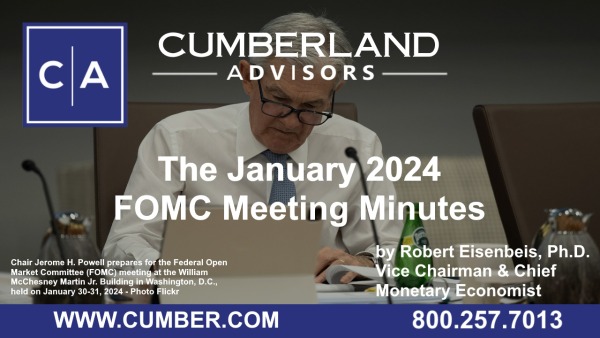Each year, the FOMC’s first order of business is to elect officers. This year, Federal Reserve Board Chairman Jerome Powell was once again elected to be chairman of the FOMC. On February 2, former president Donald Trump stated that he would not reappoint Powell as chairman of the Federal Reserve Board when his term is up in 2026.
What the former president may not fully understand that even if not reappointed as chairman, Powell would not have to leave the Board until his term is up in 2028, and unless there is a vacancy, the replacement chairman would have to be one of the remaining board members. Moreover, even if not chairman of the Board, Powell still could be elected chairman of the FOMC. While a sitting chairman of the Board of Governors has never failed to be elected chairman of the FOMC, it could happen under the current legal structure.
As for the substance of the meeting captured in the minutes, the first part of the body of the minutes focused on evidence regarding the current state of the economy, employment, and inflation. While Q4 2023 GDP was not available at the time of the meeting, staff stated that growth was “solid” in Q4 but down from the 4.9% in Q3. The subsequent advance data release confirmed the staff’s expectation when it came in at 3.3%. The staff also saw labor markets moving into better alignment, but the average pace of job gains was seen as down a bit from that in Q3. However, job gains in December (333,000) and January (353,000) far exceeded growth in Q3, and suggest perhaps an even stronger Q1 2024 than was expected. Finally, PCE inflation continued to slow to 2.6% year over year and core PCE was down to 2.9%.
Looking forward, the staff’s January GDP forecast for 2023 was slightly stronger than it was in December 2023, but because of the lagged effects of previous policy tightening and continued tight financial and credit conditions, growth in 2024 and 2025 was projected to be slightly below potential. Staff saw inflation continuing to decline in 2024 and to be close to the 2% target by 2026. However, the minutes noted that there was considerable uncertainty around these projections, although a bit less than it was in 2023.
The most interesting part of the minutes related to how participants viewed the economy and the appropriate path for policy. The economy was seen as growing at a solid rate, above 3%, bolstered by exports, inventory investment, and consumption. Labor markets were also seen as strong, with unemployment low and inflation continuing to moderate. But participants remained concerned about the elevated level of inflation and the harm it imposed upon households. Participants did see continued progress on inflation in the second half of the year; but because of uncertainty, they would be guided by incoming data. The inflation discussion also focused on key submarkets like services, housing, and the balance between supply and demand, and also noted the uncertainty surrounding their assessment. Some were concerned about the upside risks to inflation while others noted the downside risks, in part due to geopolitical events that could result in reduced demand and thus lower inflation pressures. However, overall, participants saw the Committee’s policy stance as appropriate and confirmed that the policy rate was at its peak for the current cycle.
The press noted that most participants expressed concern about moving rates up too quickly, while only two were concerned about waiting too long. This would seem to imply the Committee might be backing away from the three rate cuts that were in the December Summary of Economic Projections (SEP). Also, Chairman Powell suggested in his press conference that there would not likely be a rate cut at the Committee’s March meeting. We will learn more at that meeting, since a new set of SEPs will be provided. Clearly, for three rate cuts to materialize, GDP growth and employment would have to tank from what is the current view of the economic situation.
Links to other websites or electronic media controlled or offered by Third-Parties (non-affiliates of Cumberland Advisors) are provided only as a reference and courtesy to our users. Cumberland Advisors has no control over such websites, does not recommend or endorse any opinions, ideas, products, information, or content of such sites, and makes no warranties as to the accuracy, completeness, reliability or suitability of their content. Cumberland Advisors hereby disclaims liability for any information, materials, products or services posted or offered at any of the Third-Party websites. The Third-Party may have a privacy and/or security policy different from that of Cumberland Advisors. Therefore, please refer to the specific privacy and security policies of the Third-Party when accessing their websites.
Sign up for our FREE Cumberland Market Commentaries
Cumberland Advisors Market Commentaries offer insights and analysis on upcoming, important economic issues that potentially impact global financial markets. Our team shares their thinking on global economic developments, market news and other factors that often influence investment opportunities and strategies.


